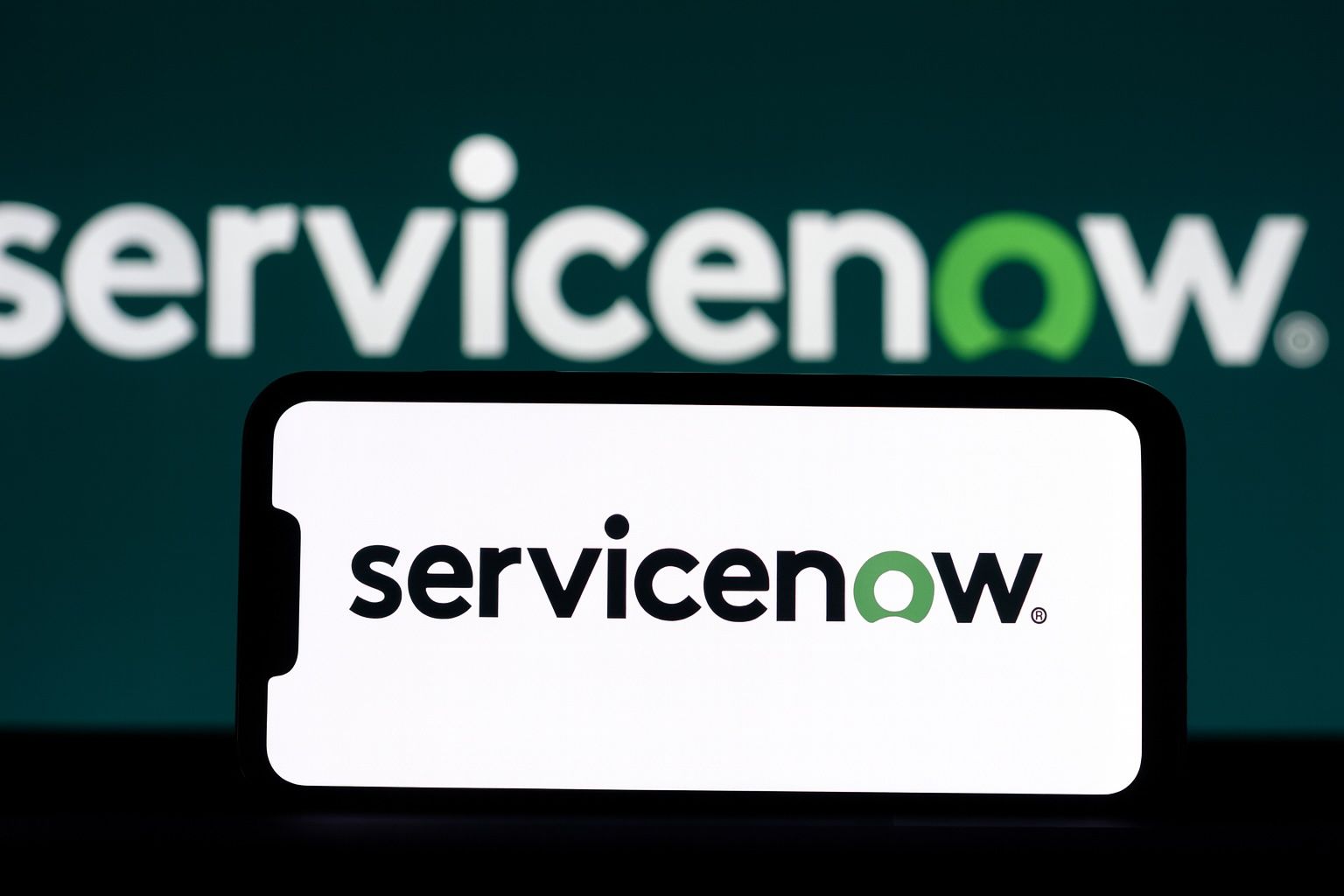- Stock price: ServiceNow (NYSE: NOW) closed around $930.17 on Friday, Oct. 24, 2025 [1], trading roughly $917–$950 over the past week [2] [3]. Shares are down about 14% YTD and roughly 20% off their 52-week high [4] [5].
- Recent moves: The stock saw modest gains earlier this week (recently up ~2% from mid-week lows) but eased slightly into the weekend. After-hours on Oct. 24 was around $932 [6]. ServiceNow’s share price remains in the mid-$900s range as investors digest mixed tech-sector signals.
- Upcoming earnings: ServiceNow will report Q3 2025 results on Oct. 29 after market close [7]. Analysts currently forecast about $4.21 EPS and $3.35B revenue for Q3, following a strong Q2 performance [8] [9].
- Q2 highlights: In Q2 FY2025 (ended June 30), ServiceNow beat estimates with $3.22 billion in total revenue (+22.5% YoY) and $4.09 EPS, topping consensus by over $0.50 [10]. CEO Bill McDermott hailed the quarter as “spectacular” with “elite level execution,” noting that ServiceNow’s AI-driven platform is “mission‑critical” as “every business process in every industry is being refactored for agentic AI” [11].
- AI initiatives & products: This fall the company rolled out its “Zurich” release, a major AI platform update featuring enhanced security, developer tools, and support for autonomous agents. ServiceNow also introduced an AI Control Tower and Agent Fabric at its Knowledge ’25 conference to govern and scale enterprise AI workflows [12] [13]. These innovations underscore ServiceNow’s push to embed AI deeply in its workflow software.
- Partnerships & deals: ServiceNow struck several high-profile partnerships this year. In September it announced the OneGov pact with the U.S. General Services Administration – offering federal agencies steep discounts on AI-enabled IT services (up to 70% off) to boost efficiency by an estimated 30% [14] [15]. The company also invested $750 million in Genesys and expanded that partnership to jointly build “agent-to-agent” AI orchestration [16]. In May at its Knowledge event, ServiceNow deepened ties with NVIDIA – unveiling a new AI reasoning model (“Apriel Nemotron 15B”) and a data “flywheel” for faster enterprise AI agents [17] [18]. Other deals include a new Ferrari Hypercar team partnership (ServiceNow’s platform now powers Ferrari’s “One Digital Portal” and race operations) [19], a U.K. VA contract ($124M) [20], and projects with AWS, Cisco and local governments (Singapore’s new secure cloud, etc.) [21] [22].
- Analyst ratings & targets: Wall Street sentiment is largely bullish. Morgan Stanley in Sept. 2025 upgraded NOW to Overweight with a $1,250 price target, arguing that short-term AI/federal worries are overblown and forecasting ~20% annual revenue growth [23] [24]. Oppenheimer (Outperform, $1,150 PT) and Stifel (Buy, $1,200 PT) have similarly high targets [25]. Even small firms like Citizens Research maintain a $1,300 target on ServiceNow [26]. By contrast, a few analysts remain cautious: Guggenheim recently cut its PT to ~$640, fearing slower AI adoption [27]. Overall, the consensus 12-month target is about $1,100 (roughly 15–20% above current levels) [28], with roughly 41 Buys vs. 1 Sell in the analyst poll [29].
- Insider moves: Some insiders have taken profits: CEO McDermott sold ~$5.3 million of stock in late August (nearly half his holdings) [30]. Meanwhile the company itself is returning cash – repurchasing $361 million of shares in Q2 as part of its $4.5B buyback program [31].
Stock Performance & Market Context
ServiceNow’s shares have been choppy this fall, mirroring swings in tech stocks. After hitting an all-time high (~$1,198) earlier in 2025, the stock corrected as broader tech indices have advanced only modestly. The S&P 500 tech sector is up on the year, but ServiceNow underperformed amid concerns over U.S. federal IT budgets and AI-related valuation risk [32] [33]. For example, a recent pullback brought NOW down near the mid-$900 range. In late July the stock briefly spiked (~+5%) on a strong Q2 earnings beat, but gave back gains in September as investors grew wary. Volume and momentum: Trading volume has averaged around 1–1.3 million shares recently, and NOW is forming a base near its 50-day moving average. If demand for AI-driven software remains strong, some analysts argue the October earnings could trigger a rebound in the stock.
Analyst Commentary
Wall Street analysts note that ServiceNow’s valuation remains high (trading above 100× forward earnings), but many believe its growth story justifies it. Morgan Stanley’s analyst wrote that ServiceNow is “well positioned to deliver generative AI capabilities,” and sees an attractive risk/reward given sustainable ~20% subscription revenue growth [34]. Similarly, Oppenheimer argues that the recent pullback presents a “unique opportunity” to buy a quality name at a discount [35] [36]. Valuation skeptics (like Guggenheim) counter that enterprise AI roll-out might lag expectations [37]. In the meantime, several tech analysts highlight ServiceNow’s customer momentum and pipeline. CEO McDermott emphasizes the company’s large customer base and renewal rates, noting “85% of the Fortune 500” use ServiceNow [38]. Norwest Partners analyst Rebecca Wettemann (Valoir) observes that ServiceNow’s AI-optimized platform and ecosystem could shift the customer service landscape, calling the Genesys alliance a “notable development advancing the industry toward scalable agentic AI” [39].
Technology & AI Edge
ServiceNow is betting heavily on AI to drive growth. Executives stress that its platform is becoming an “AI operating system” for enterprises. As McDermott put it, “ServiceNow has never been more differentiated as a full-stack agentic operating system” [40]. Senior VP Jon Sigler adds that the new NVIDIA-backed AI model will power “intelligent AI agents that can make context-aware decisions, adapt to complex workflows, and deliver personalized outcomes at scale.” [41]. In practice, ServiceNow is integrating AI into areas like IT service, customer support, HR and CRM. For example, its “AI Agent Fabric” now orchestrates virtual assistants across systems (including Genesys contact centers) [42] [43]. This AI angle has attracted investor attention – especially given recent tech enthusiasm for AI – but also scrutiny, since the stock’s lofty valuation reflects high expectations.
Outlook & Price Targets
Looking ahead, analysts generally see upside once fears abate. The midpoint of analyst targets suggests potential gains toward the $1,100–$1,300 range in the next 12 months [44] [45]. However, much depends on upcoming catalysts: the Q3 earnings and guidance (Oct. 29), any updates at ServiceNow’s Knowledge conference (coming this week), and broader tech sector trends. As one analyst put it, “any new guidance or commentary on AI demand could sway the stock’s next move,” validating whether the bulls or bears are right [46]. In short, investors are watching to see if ServiceNow can sustain ~20% growth and translate its AI investments into results. For now, the stock has found some support around $900–$930; a break above $950–$970 could signal renewed momentum toward higher price targets.
Sources: ServiceNow company releases and press reports [47] [48] [49] [50]; financial news and analysis [51] [52] [53].
References
1. www.investing.com, 2. stockanalysis.com, 3. ts2.tech, 4. ts2.tech, 5. ts2.tech, 6. stockanalysis.com, 7. www.servicenow.com, 8. www.marketbeat.com, 9. www.servicenow.com, 10. www.marketbeat.com, 11. www.servicenow.com, 12. ts2.tech, 13. www.servicenow.com, 14. www.nextgov.com, 15. www.nextgov.com, 16. www.genesys.com, 17. www.servicenow.com, 18. www.servicenow.com, 19. www.servicenow.com, 20. www.investing.com, 21. www.servicenow.com, 22. www.servicenow.com, 23. www.tipranks.com, 24. ts2.tech, 25. www.investing.com, 26. www.investing.com, 27. ts2.tech, 28. ts2.tech, 29. ts2.tech, 30. ts2.tech, 31. www.servicenow.com, 32. ts2.tech, 33. ts2.tech, 34. www.tipranks.com, 35. ts2.tech, 36. ts2.tech, 37. ts2.tech, 38. ts2.tech, 39. www.genesys.com, 40. www.servicenow.com, 41. www.servicenow.com, 42. www.genesys.com, 43. www.servicenow.com, 44. ts2.tech, 45. www.investing.com, 46. ts2.tech, 47. www.servicenow.com, 48. www.servicenow.com, 49. www.nextgov.com, 50. www.servicenow.com, 51. ts2.tech, 52. www.tipranks.com, 53. www.investing.com










